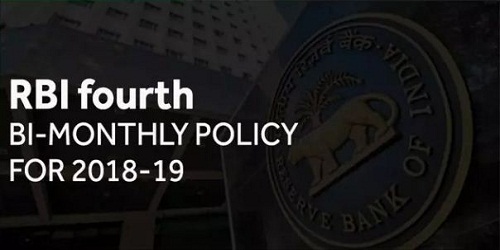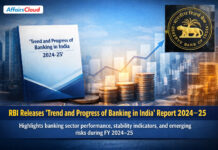On October 5, 2018, Reserve Bank of India, the central bank of India, released its 4th bi-monthly monetary policy.
 The next meeting of the MPC is scheduled from December 3 to 5, 2018.
The next meeting of the MPC is scheduled from December 3 to 5, 2018.
Key Points:
- The Repo rate has been kept unchanged at 6.5%.
- The Reverse Repo rate is 6.25% , Marginal Standing Facility (MSF) and Bank rate is 6.75% also remaining unchanged.
- CRR remains at 4% and SLR at 19.5%.
- Real gross domestic product (GDP) growth surged to a nine-quarter high of 8.2 per cent in Q1:2018-19.
- GDP growth projection for 2018-19 is retained at 7.4 per cent as in the August resolution (7.4 per cent in Q2 and 7.1-7.3 per cent in H2).
- GDP growth for Q1:2019-20 is now projected marginally lower at 7.4 per cent as against 7.5 per cent in the August resolution.
- Retail inflation, measured by the y-o-y change in the CPI, fell from 4.9 per cent in June to 3.7 per cent in August mainly due to decline in food inflation.
- Actual inflation outcomes, especially in August, were below projections from previous bi-monthly policy of 4.6 per cent in Q2:2018-19, 4.8 per cent in H2 and 5.0 per cent in Q1:2019-20.
- Exports increased to 12.7 per cent due to non-oil exports and global high demand and driven mainly by petroleum products.
- Imports grew faster than exports, reflecting not only a higher oil import bill, but also higher imports of gold, coal, electronic goods and machinery.
- Thus, Trade deficit increased to US$ 35.3 billion in July-August 2018 from US$ 24.6 billion a year ago.
- However, the current account deficit could be maintained to 2.4 per cent of GDP in Q1:2018-19 from 2.5 per cent a year ago, mainly due to higher net services receipts and private transfer receipts.
- Net foreign direct investment (FDI) flows improved in April-July 2018 due to higher US interest rates, risk-off sentiment in EMEs and escalation of trade wars.
- As on September 28, 2018, India’s foreign exchange reserves were at US$ 400.5 billion.
Liquidity:
- Liquidity oscillated between surplus and deficit during August-September 2018.
- It was a daily net average surplus of ₹201 billion during August 1-19, 2018 and moved into deficit during August 20-30.
- Reserve Bank conducted two open market purchase operations in the second half of September to inject $200 billion of durable liquidity.
- Thus,on a daily net average basis,$ 30 billion was in August and $406 billion was injected in September.
- Thus due to initial liquidity crunch, the weighted average call rate (WACR), on an average, traded below the repo rate by 15 basis points (bps) in August and by 4 bps in September.
Sector Wise:
i .In case of Agricultural growth, production of major kharif crops for 2018-19 rose and live storage in major reservoirs increased to 76% which was 17 per cent higher than last year and 5 per cent higher than the average of the last 10 years.
ii. In Industrial Sector measured by index of industrial production (IIP),:
- High growth in consumer durables and non-durables,
- The infrastructure and construction sector continued to show solid growth,
- Primary goods growth accelerated, driven by mining, electricity and petroleum refinery products,
- The output of eight core industries growth remained strong in July, driven by coal, petroleum refinery products, steel and cement, but moderated in August.
- Manufacturing sector saw robust growth witnessed by manufacturing purchasing managers’ index (PMI) .
- Led by enhanced production, order books, exports and capacity utilization based on Reserve Bank’s business expectations index (BEI ), the sectors improved.
iii. In Services sector:
- Indicators of rural demand, viz.,growth in tractor and two-wheeler sales, slowed down,
- Passenger vehicle sales, an indicator of urban demand, declined possibly due to rising fuel prices,
- Air traffic growth remained robust,
- Steel consumption and cement production, Transportation sector showed growth,
Viewpoint about other countries:
i. Among advanced economies (AEs), the United States (US) economy appeared to have sustained pace in Q3:2018 as reflected in strong retail sales and robust industrial activity.
ii. In case of Euro, the economic activity remained restrained due to weak economic activity and political uncertainty.
iii. In case of Economic activity in major emerging market economies (EMEs):
- China: industrial production growth has moderated with slowing exports.
- Russia: the manufacturing sector is turning around, and the employment scenario remains upbeat.
- Brazil: economic activity is recovering from the setback and there is low domestic demand and manufacturing.
- South African economy slipped into recession in Q2:2018, pulled down by the negative contribution from agriculture on account of a strong unfavourable base effect.
Monetary Policy Committee Consisted of :
Dr. Pami Dua, Dr. Ravindra H. Dholakia, Dr. Michael Debabrata Patra, Dr. Viral V. Acharya and Dr. Urjit R. Patel and Dr. Chetan Ghate.
RBI:
♦ Founded: 1st April 1935.
♦ Headquarters: Mumbai.
♦ 24th Governor: Dr. Urjit Patel.
Overview of the policy rates and reserve ratios:
| Categories | 4th Bi-Monthly in percent | 3rd Bi-Monthly in per cent |
| CRR | 4 | 4 |
| SLR | 19.5 | 19.5 |
| Repo Rate | 6.5 | 6.50 |
| Reverse Repo rate | 6.25 | 6.25 |
| MSF | 6.75 | 6.75 |
| Bank Rate | 6.75 | 6.75 |




